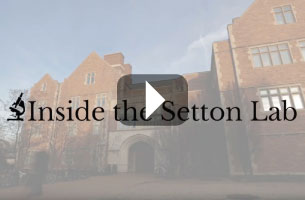Q&A with Lori Setton
Chair of the Department of Biomedical Engineering and the Lucy & Stanley Lopata Distinguished Professor of Biomedical Engineering

What have you learned about the department you didn't know before?
I learned that the department and the university have a supportive culture and climate for entrepreneurship and tech transfer. I had no idea before I came here that there would be so many resources and such a deep commitment to really rapidly translating ideas into inventions.
What are your goals as chair?
I am eager to build upon the traditions of research excellence at WashU BME in cardiac bioengineering, medical imaging, neuroengineering from devices to systems, and in molecular and cellular engineering. At the same time, we have an opportunity to expand our strengths in regenerative bioengineering in partnership with the School of Medicine. So I expect to make faculty hires that will take on leadership roles to shape and define BME for the future.
For a student who studies biomedical engineering, what can the future hold?
It is widely known that biomedical engineering is one of the few engineering disciplines that continues to grow and expand at all levels. The interest in hiring our students is only growing, and the ability to generate new industries, new market sectors and new products is only increasing, particularly as the health-care sector becomes an even larger part of our economy. Biomedical engineering is at the bottom of what I think will be a very long growth curve.
We have to respect and understand that many of these engineering undergraduate degrees are not even 25 years old, and employers are just beginning to understand the value that this pool of graduates is providing.
What challenges do biomedical engineering students face, and how is the department preparing them for those challenges?
We don't yet fully understand the world that our students are going to inhabit even 15 or 20 years from now. Technology is evolving so quickly. Even global economies are changing on the order of five to 10 years. We are trying to prepare students to be capable, competitive and successful in almost any enterprise and in the future. I think we have to ensure that they are excellent communicators, are fearless in mastering new disciplines, and they are self-motivated and can work independently. I think biomedical engineering does a great job of preparing them with these talents and skills.
What are the challenges for women in the biomedical engineering field?
There are always constituents who are underrepresented, underserved and undervalued. Women in biomedical engineering definitely feel that at the professional level and at the academic faculty level. In my time in academia, I've watched the representation of women students in BME grow from about 20 percent to our current level of 50 percent at the undergraduate level. I like to think that their experience now, with half of their class being female, is pretty positive and that they feel like they have a community that they can work with to complete problem sets, design projects and where they get support in lab research. But I certainly don't think that women either in professions or in academics have that same sense of community right now. Essential to my happiness and retention in academia has been a small but close-knit group of female mentors that have served me well throughout my career. I have needed them as sounding boards to process responses to my scholarship, evaluations, opportunities and simply daily life.
Big on my agenda, and I think on the whole school's agenda, is to increase representation of under-represented minorities. I've just stepped into this chair role, but I'm starting to talk about what we can do to broaden diversity. We created the Chair's Fellowship, which creates incentives for under-represented students when they sign up for graduate school at WashU. We have also begun to create opportunities through WashU's many NIH training grants to support broader professional development for minority students.
What is your role with the Biomedical Engineering Society?
I am currently president of BMES. The 50th anniversary is in 2018, so we're preparing for one big birthday party. It is important for me to contribute to BMES, a wonderful community of colleagues and scholars that has historically been the home for everything related to biomedical engineering education. That community is where we recruit our faculty candidates and students and share best practices. Part of what I've been working toward is to make it the go-to home for continued professional learning, and a first step has been contributing to the generation of the 10th BMES industry chapter here in St. Louis, now enjoying its first year.
What do you consider your biggest accomplishment so far?
I think my greatest accomplishment is graduating many, many students and mentoring a large number of post-docs who have remained invigorated by research, both academic and corporate research, and have remained engaged in advancing knowledge at some level. I think I've had about 20 PhD students and more than 20 post-docs, and I now enjoy seeing them spread their knowledge and influence nationally.





